


|
NEW STATES : INDEPENDENT KINGDOMS The second half of the III millennium sees the appearance in Lower and Middle Nubia of two new political entities: the C-Group and the Kingdom of Kerma.
THE C-GROUP, POST-NEOLITHIC POPULATIONS (c. 2400-1450 BC) The disappearance of the A-Group leaves more or less empty a territory which comes under Egyptian domination during the Old Kingdom. The return of the populations to a sensitive area suggests new climatic conditions were forcing some groups, maybe originating from the savannahs of the Third Cataract, to approach the Nile valley. From an anthropological perspective, these communities seem to have been linked to those of the kingdom of Kerma on the Middle Nile upriver from the Third Cataract. Their origin is the great palaeo-Saharan culture, giving them African characteristics. Following the example of the A-Group, they live from agriculture, cattle rearing and control the tracks leading to the stone quarries and to the gold and copper mines. At the end of the III millennium, the C-Group is made up of principalities that are sufficiently strong for the Egyptians to recognise them as separate entities which they called Wawat, Irtjet or Setau populations. To read more, click here (annexe 1) |
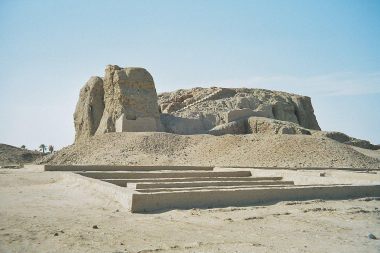 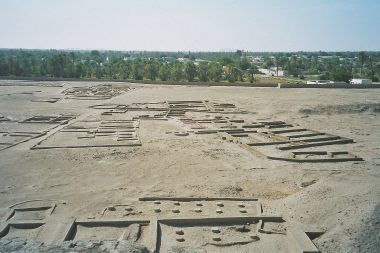 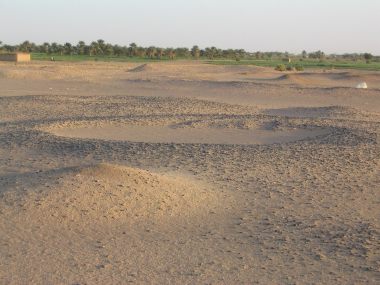 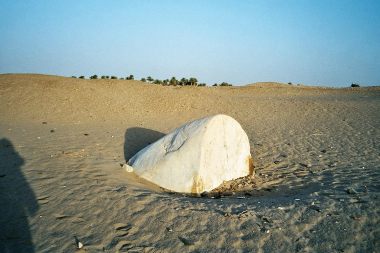 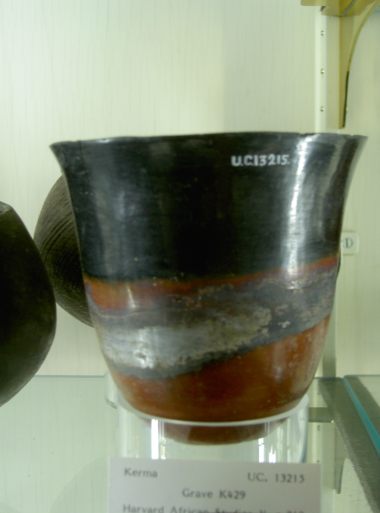 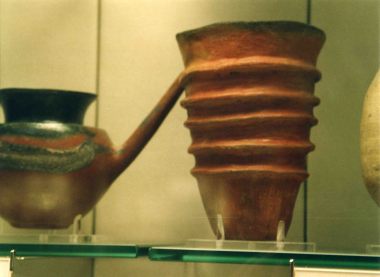 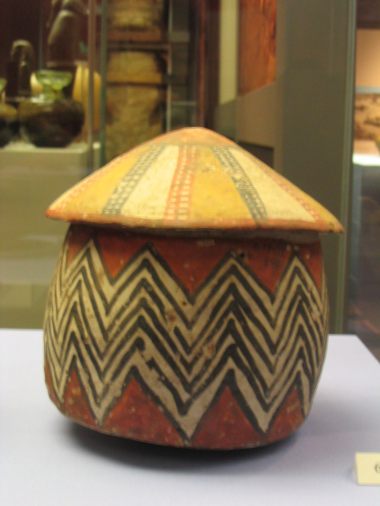 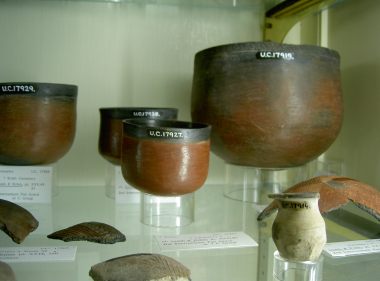 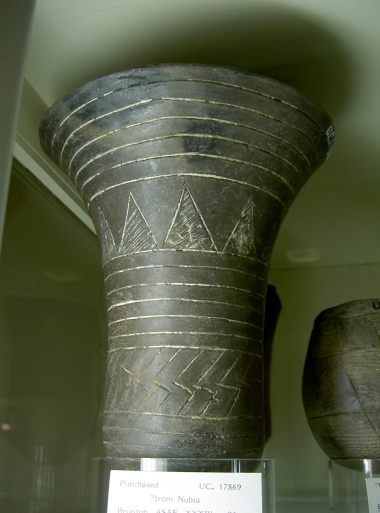 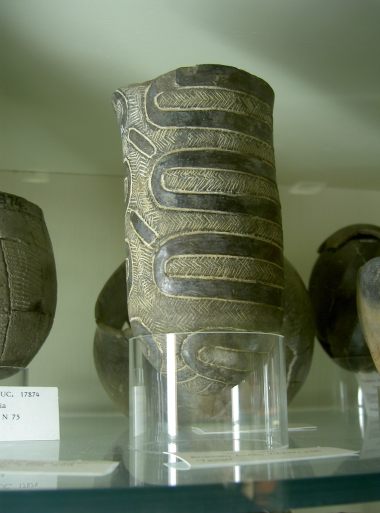 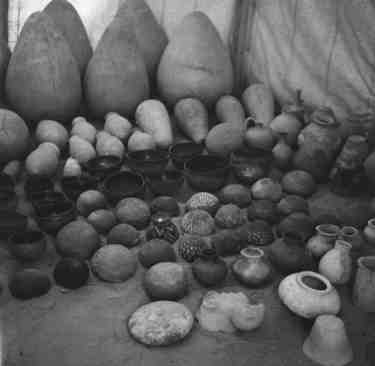 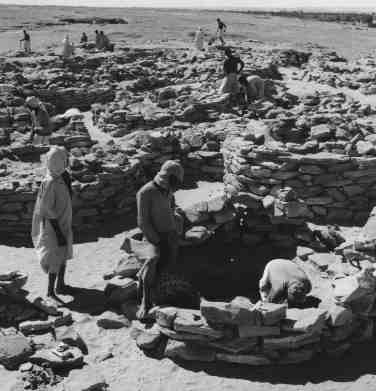 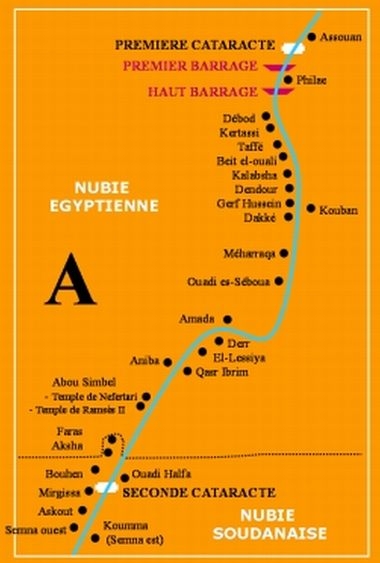 The main temple in the Kerma city / Temple principal de la cité de Kerma
Vestiges of official buildings in the city of Kerma / Arasements de bâtiments officiels dans la cité de Kerma
Tombs tumuli in the cemetery of Kerma / Tumuli de la nécropole de Kerma
Cone in dolomitic marble placed on the top of some graves-tumuli in the cemetery of Kerma / Cône en marbre dolomitique qui était placé sur le sommet des tumuli de la nécropole de Kerma
Kerma tulip vase / Vase tulipe de Kerma avec bande médiane métallescente
Kerma ceramic / Céramique de la période de Kerma
Ceramic having a shape of hut looking like the vestiges of similary building in the city of Kerma / Céramique en forme de hutte rappelant le bâtiment dont les arasements sont visibles dans la cité de Kerma
Ceramics of Group A or C and Pan Grave / Céramiques du groupe A ou C et des Pan Grave
Caliciform vase with setting similar to Group C / Vase caliciforme au décor type groupe C
Caliciform vase with setting similar to Group C / Vase caliciforme au décor de type groupe C
Among these ceramics, some from the group C culture, excavated by the Scandinavian Mission during the Unesco campaign 1960-1968 / Ensemble de céramiques dont certaines du group C, excavées par la Mission Scandinave durant la campagne de l'Unesco 1960-1968
Group C graves from Serra (Second cataract) excavated during the Unesco campaign 1960-1968 / Tombes du groupe C de Serra étudiées durant la campagne de l'Unesco 1960-1968
Egyptian settlements started by the Middle Kingdom rulers on the Second cataract / Implantations égyptiennes commencée par les souverains du Moyen Empire sur la Seconde Cataracte
|
|
These fortresses were eleven in number (from North to South): Buhen, Kor, Abusir, Mirgissa, Dabenarti, Askut, Shelfak, Uronarti, Semna West and Semna South and Kumna.
To learn more, click on Archaeological sites, Unesco campaign and consult the slide show On the fall of the Middle Kingdom and during the Egyptian Second Intermediary Period, the C-Group enters a second stage of development (c. 1900-1600 before our era). The villages become increasingly important; some, like Wadi es-Sebua and Areika, are fortified. The economic development is still dependent on contact with the North, but without the loss of independence. Aniba becomes the seat of one of the great principalities of the C-Group. The economic success translates into the production of very beautiful ceramics with geometric patterns, highlighted by strong and contrasting colour schemes. It is one of the most beautiful among the Nubian art corpus. Funerary customs evolve through the hierarchisation of the local chiefs.
To learn more, click here (annexe 2) The autochtonous populations are joined by Egyptian colonists (civil servants, architects and artisans), who had install themselves by the fortresses during the Middle Kingdom. They bring to the South hitherto unknown technologies. Did the C-Group disappear? Yes, but in a different manner to the A-Group. It dissolved in the Egyptian melting pot when the North once more became powerful (during the New Kingdom). The Nubian elite preferred acculturation to war, so as to preserve its populations and protect its commercial interests.
On this subject, consult La Nubie des Pyramides.
THE KINGDOM OF KERMA At the beginning of the III Millennium, a culture called the Pre-Kerma developed between the Batn el-Haggar and the Fourth Cataract. Of African origin, it gives birth to the kingdom of Kerma. The geographical position of this kingdom is exceptional. Located at the beginning of the Belly of Stone (Batn el-Haggar), it covers large plains whose fertility is an asset at the end of the desertification of the 22nd Parallel North. The kingdom of Kerma is located not only on the river and terrestrial routes of the Corridor of Africa, but also opens out in the direction of the Red Sea, the land of Punt (to the south-east) and probably towards the regions of Darfur and Kordofan (to the south-west).
The Archaeological Mission on the island of Sai has unearthed silo-pits dating to 2700 BC. The Mission of the University of Geneva excavated in 1986 huts with a round base. From 2400 BC the drying-out of the savannas forced the Pre-Kerma settlement to move closer to the river. It gave birth to the first great Nilotic kingdom (2400-1450 BC) south of that of Egyptian Nile Valley. Marked by strong African traditions, and despite the absence of written records, research has confirmed its key role in the chain of exchange, following the example of the A- and C-Groups. The capital Kerma, located above the Third Cataract, was the heart of the Nubian identity. With regard to the excavations undertaken, notably at Sai, in the town and necropolis of Kerma and in the basin at Gism el-Arba, three great periods stand out: Kerma Ancien (ca 2400-2050, Kerma Moyen (ca 2050-1750 BC) and Kerma Classique (ca.1750-1450 BC).
KERMA ANCIEN (ca 2400-2050 BC) Near the Nile, the sedentary populations are characterised by a hierarchic system that one observes in the funerary domain, with ritual sacrifice where some skeletons surround with their arms the cranium of the main inhumation. The rites recall those of earlier periods: pit burials, the tumulus covered with white pebbles, surrounded by circles of black stones. The funeral was conducted in the presence of the family or close associates (on the east part of the grave cut one finds several receptacles and to the south, bucrania, suggesting a funerary ceremony). Around 2200 BC some tumuli reach 8 m in diameter. The craft traditions do not change, and the potters continue making magnificent red bowls with black rims, decorated with finely incised motifs.
KERMA MOYEN (ca 2050-1750 BC) A period of transition, dating to around 2100 BC, it confirms an evolution of the funerary rites. It includes the presence of lambs and sheep near the bed of the dead, the symbolic receptacle (hypostasis) of the god Amun. The animals wear a disc of feathers fixed to the head with the help a of a leather lace. Holes drilled through their horns allowed the fixing of two beaded pendants, recalling the rams with discs on rock drawings. The Kerma Moyen pursues religious traditions with a hierarchic system linked to economic development. In the graves food offerings become more important, and the grave furnishings (traces of a bed whose legs could be covered in gold leaf, tables, chairs and personal objects) suggest an evolving society. Some tumuli can be as large as 25 m in diameter, covering a grave cut of some 12 m. The graves of princes have yielded very beautiful ceramics asserting the primordial role of libations, symbolising rebirth. The presence of sacrifices seems essential. The capital is fortified and the cult area includes a specific zone called a secondary agglomeration, its function possibly related to the royal and funerary worlds. The ancient town included all classes of society, with the elite making up a large part of the population.
KERMA CLASSIQUE (ca 1750-1450 BC) The rise of the Kerma Classique period seems to be linked to the fall of the Middle Kingdom and to the Egyptian Second Intermediate Period (ca. 1797-1543 BC). After the reign of Sesostris III (XIX Century BC), no military expeditions are sent to Lower Nubia. The departure of the Egyptian garrisons allows the Kingdom of Kerma to extend its influence, probably as far as the town of el-Kab in Upper Egypt. Direct contacts with the Hyksos kings, installed in the northern half of Egypt have been proved. An inscription has been found in the tomb of a governor of the XVII Dynasty, Sobeknakht. It mentions that Kush (the kingdom of Kerma) had invaded a territory extending ‘as far as the neighbourhood of the Asians’, that is to say near Thebes, an event ‘without precedent since the time of the god’. This testimony, discovered by a mission from the British Museum in 2003, has underlined the power of the kingdom of Kerma, a civilisation that according to Charles Bonnet was ‘predominant in the Nile valley’. To learn more, click here (annexe 3) The remains of the royal city and of the cemetery substantiate a belief in a divine world and in a life after death. Nevertheless, the practice of ritual sacrifices contributed to the weakening of the kingdom when incursions from the north began again.
The capital was destroyed by an Egyptian expedition. According to Charles Bonnet, ‘Contrary to the Egyptian customs, the New Kingdom colonisation began with the destruction of the areas of worship and the total abandonment of the cemeteries and the town’. The kingdom of Kerma is no more. This was the status quo for several centuries until the beginning of the I Millennium BC with the emergence of the XXV Dynasty, that of the Black Pharaohs.
On this subject, consult ‘La Nubie des Pyramides’
|
|